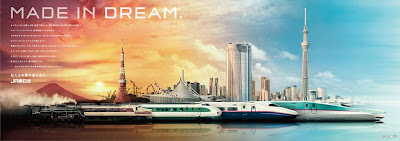The Hayabusa
The Hayabusa (peregrine falcon in Japanese) is the newest addition of train services on East Japan Railway Company’s Tōhoku Shinkansen (Tōkyō and Shin-Aomori). It is the new flagship limited-stop express train to enter service on 5 March 2011 initially running 3 trips daily in each direction.
The fastest of Hayabusa, No. 1, 3, and 6, calling only at 3 intermediate stations, take 3 hour and 10 minutes to complete the 675 km (419 miles) Tōkyō-Aomori trip, 10 minutes faster than the current flagship, the Hayate (violent wind in Japanese). The fastest segment of the Hayabusa’s entire journey is between Utsunomiya and Morioka with a top speed of 300 km/h (187 mph). This speed will increase to 320 km/h (199 mph) in 2013.
The first train to serve on the Hayabusa service is the Series E5 built by Kawasaki and Hitachi. It is the first train in Japan to feature a new luxurious class accommodation dubbed the Gran Class.
The E5 has previously been mentioned by Train of the Week and the post is linked here. More technical details including new technologies used on the E5, official images and films of the E5 can be found on the Hayabusa’s homepage here.
The fastest of Hayabusa, No. 1, 3, and 6, calling only at 3 intermediate stations, take 3 hour and 10 minutes to complete the 675 km (419 miles) Tōkyō-Aomori trip, 10 minutes faster than the current flagship, the Hayate (violent wind in Japanese). The fastest segment of the Hayabusa’s entire journey is between Utsunomiya and Morioka with a top speed of 300 km/h (187 mph). This speed will increase to 320 km/h (199 mph) in 2013.
Hayabusa's debut television advert
The first train to serve on the Hayabusa service is the Series E5 built by Kawasaki and Hitachi. It is the first train in Japan to feature a new luxurious class accommodation dubbed the Gran Class.
Evolution of railway travel in Northeast Japan
This must be the prettiest (or ugliest) train in the world
The E5 has previously been mentioned by Train of the Week and the post is linked here. More technical details including new technologies used on the E5, official images and films of the E5 can be found on the Hayabusa’s homepage here.



Comments